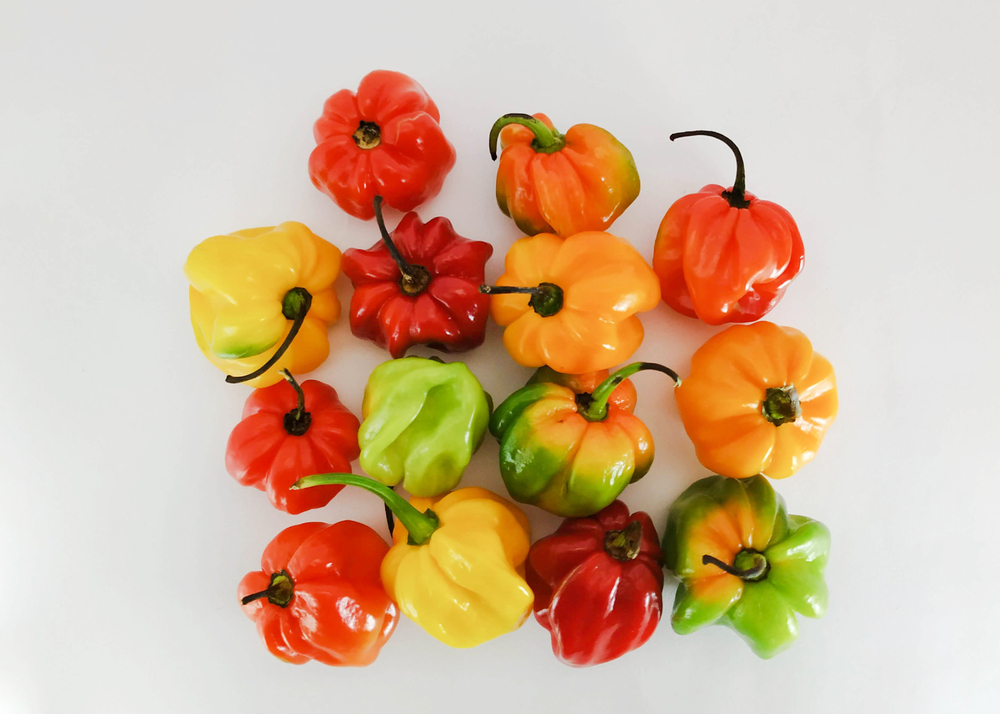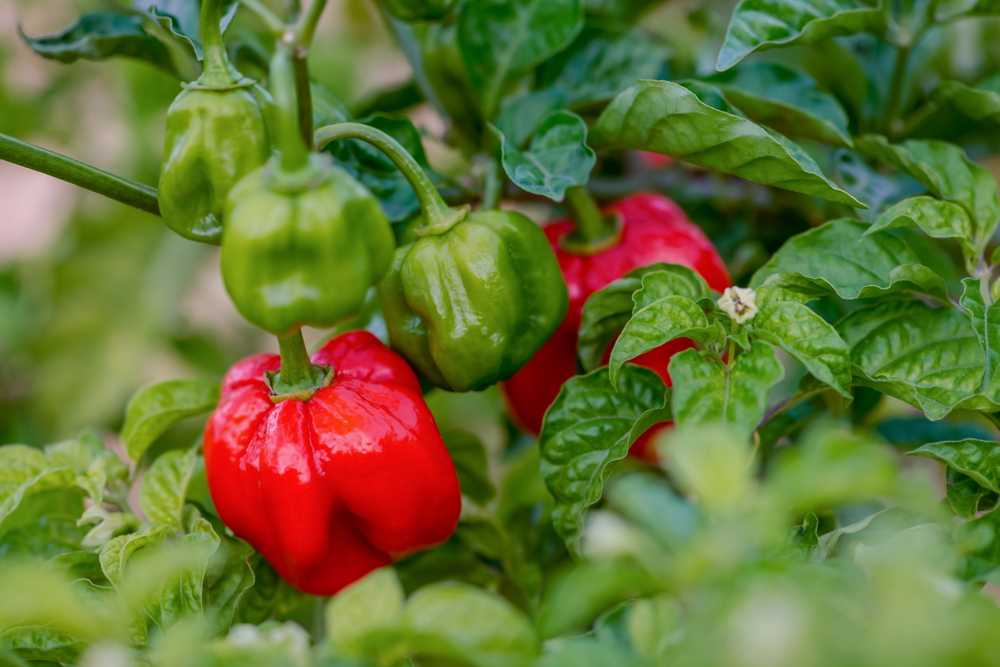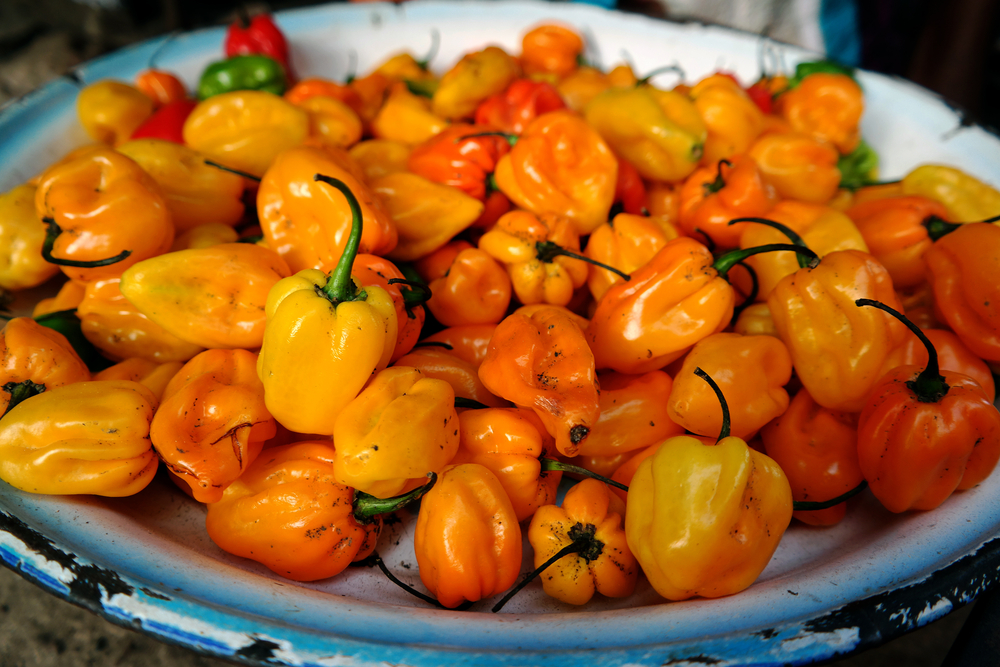Despite their innocent-sounding name, Scotch Bonnet peppers are some of the hottest, with an SHU of 100,000–350,000. These peppers are the official chili of Jamaica and are widely used in Caribbean cooking.
What Is A Scotch Bonnet Pepper?
The Scotch Bonnet pepper is a variety of hot chili pepper with a slightly fruity taste and unique flavor. Its sweet and tropical flavor pairs well with island flavors, including fresh fruit like mango and pineapple.
The pepper’s spice level is often considered the highest you would go among the true culinary chilies. Meaning, the Scotch Bonnet is used in dishes that are considered very spicy, but not so spicy that you’d win a free t-shirt if you ate a plate of wings cooked in them.
The Scotch Bonnet pepper variety is a popular choice in the Caribbean. It is a key ingredient in famous West Indian or Caribbean pepper sauces.
These peppers range in color from green to yellow, orange, red, and brown. They sport a patented squat, round shape with deep ridges.

How Hot Are Scotch Bonnet Peppers?
The Scotch Bonnet pepper ranges from 100,000 – 350,000 on the SHU (Scoville Heat Units) scale.
A cultivar of habanero, the Scotch Bonnet pepper is among the world’s hottest peppers. Ever tried a habanero pepper? If yes, you certainly know it features some serious heat. While the habanero is a suitable replacement for Scotch Bonnet peppers, it’s significantly less spicy! The cousins also share some similarities and differences in appearance and taste (spice aside).
Compared to the jalapeno pepper, which averages roughly 5,000 SHU, the Scotch Bonnet pepper packs plenty of punch (up to 140 times hotter).
The Scotch Bonnet pepper is 2 – 12 times hotter than the cayenne pepper, a significant heat upgrade.
Many hotter chilis than the Scotch Bonnet peppers on the Scoville scale exist. The most notable are the Carolina reaper and super-hot ghost pepper, coming in at 3 – 10 and 4 – 22 times hotter than the Scotch Bonnet.
Bottom line: While the Scotch Bonnet pepper features significant heat, its spiciness does not rival some of the world’s hottest peppers.
Other Names Scotch Bonnet Peppers Go By
Scotch Bonnet peppers are sometimes called fresh pepper, Ata Rodo, flower pepper, Bonney pepper, or Caribbean red pepper.
Varieties Of Scotch Bonnet Peppers
Different varieties of Scotch Bonnet peppers exist.
Some of the popular ones include;
- The Bahama Mama
- The Martinique Pepper
- The Bahamian
- The Capsicum Chinense
- The Jamaican Hot
Can You Grow Scotch Bonnet Peppers?
Despite the many varieties of Scotch Bonnet peppers, growing them will be similar, whether they’re the classic land variety or a rare cultivar. Choose the type that interests you the most. Each plant can produce dozens and dozens of peppers.
They’re perennials (lasting 3-5 years) and grow in tropical climates, so they’ll do best in warm southern states with longer growing seasons.
Plant them from seed indoors around six weeks before the last frost. The period of indoor growth is crucial in prepping the pepper plants for the outdoors as the weather warms up.
The pepper seeds germinate best between 80 – 90 degrees F.
Here’s what you’ll need to start growing seedlings indoors:
- Water and spray bottle
- Seeds
- Grow light (optional)
- Seed potting mix or starting mix
- Seed cell trays
- Seed heating mat (optional)
When the seedlings are ready to transplant, follow this guide for planting them outside in a warm, sunny spot with good drainage.

Scotch Bonnet Peppers In Cooking
Scotch Bonnet peppers can be used as you would any other type of hot chili pepper:
- As a sauce
- As a marinade or meat rub
- As a spice rub
- As garnish
- For seasoning
Scotch Bonnet peppers are NOT a substitute for mild or sweet chili peppers.
Scotch Bonnet has gained popularity in Caribbean cooking and hot sauces. It pairs well with tropical fruits and Caribbean regional spices, like:
- Allspice
- Cinnamon
- Cloves
- Cumin
- Ginger
- Nutmeg
- Star Anise
CAUTION:
Be sure to exercise caution when using this pepper in your cooking. In addition to using the appropriate amount for your heat tolerance (start small; you can always add more!), you should always wear gloves when handling fresh peppers.
Avoid touching or rubbing your eyes when handling powdered and fresh variants, as capsaicin oil can cause a burning sensation that lasts for hours. Check out these DIY methods to soothe your skin if you get a pepper burn.
Where To Buy Scotch Bonnet Peppers
Finding Scotch Bonnet peppers is easy in well-stocked grocery stores and Latin grocers.
Amazon also stocks a variety of dried Scotch Bonnet peppers.
Finally, if you live in a warm climate, check your local farmers’ markets in the summer.
Substitutes For Scotch Bonnet Peppers
Can’t buy or grow Scotch Bonnet peppers? Well, the good thing is that plenty of alternatives are available for your recipe.
Here are some great alternatives to consider:
- Habanero chilis
- Serrano chils
- Thai red chils
- African Bird’s Eye chils

